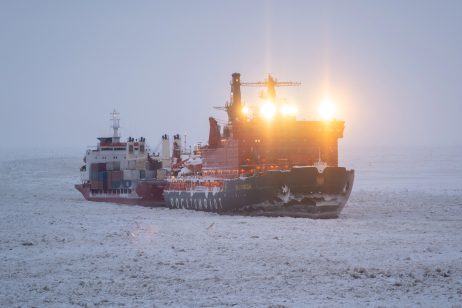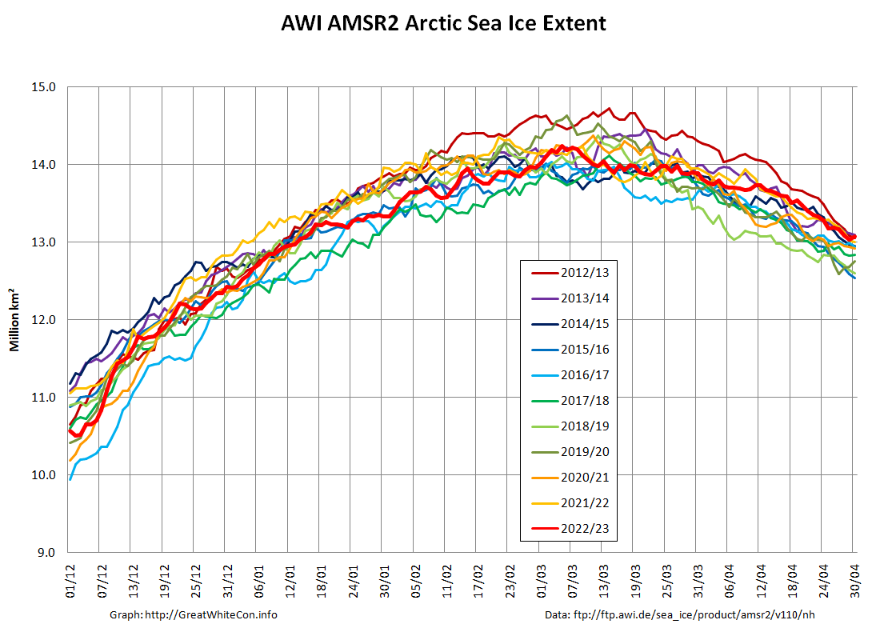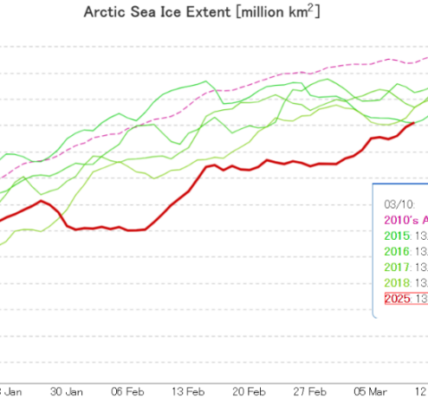Moscow sees China, India, and other Asian powers as critical for the future of the Northern Sea Route in Arctic, but their involvement remains limited.
Russia’s ambitions to expand the global utilization of the Northern Sea Route (NSR) have re-emerged in global discourse, with Rosatom forecasting a 50 percent rise of foreign vessel traffic through its Arctic corridor. The announcement, made despite ongoing Western sanctions and regional instability caused by the war in Ukraine, reflects Moscow’s strategic bid to recast the Arctic as a new maritime frontier dominated by Russian infrastructure and legal control.
With climate change gradually opening northern waters and China, India, and other Asian powers eyeing polar routes for faster Asia-Europe trade, the NSR seems poised for a new era. Yet, critical questions remain: Can Russia truly turn the NSR into a viable global shipping lane? And if so, at what cost? While the NSR offers potential savings in distance and fuel, its operational, political, legal, and environmental challenges are far from being addressed. Russia’s unilateralist strategy risks turning this strategic corridor into a geopolitical fault line rather than a connective artery.
Russia’s NSR Push: Ambition and Context
Backed by massive state investment, the Kremlin has prioritized the modernization of Arctic ports, the construction of a powerful fleet of nuclear icebreakers (including the Arktika-class vessels, the world’s most powerful), and a digital traffic control system. This infrastructure upgrade aims to make the NSR operational for a longer navigation season and attractive to international commercial partners.
Moscow views the NSR not merely as a shortcut between Europe and Asia, but as a strategic lifeline for its energy exports – particularly liquefied natural gas (LNG) from flagship projects like Yamal LNG and Arctic LNG 2. Russian officials project that Arctic transit volumes could soar to 200 million tons by 2030, a dramatic rise from approximately 35 million tons in 2023. However, this ambitious outlook contrasts sharply with the cautious stance of Western shipping companies, many of which have withdrawn from joint ventures or suspended operations due to sanctions. In reality, NSR shipping activity continues to fall well short of Russia’s projections.
Russia also counts on China as a crucial partner in developing its Arctic ambitions. China’s “Polar Silk Road” concept, first announced in 2018, envisioned sustained Chinese investment and participation in Arctic shipping and infrastructure along the NSR. This vision was reinforced by the signing of a Memorandum of Understanding between China and Russia in 2022 to deepen cooperation on Arctic development, covering areas such as shipping, energy, and scientific research.
Despite the formal commitments, China has moved cautiously. Since 2022, Chinese activity along the NSR has been limited and carefully calibrated. While there have been a few recorded transits – most notably by NewNew Shipping Line in 2023 – Beijing has refrained from large-scale operations or headline investments in Russian Arctic infrastructure. That said, 2024 saw Chinese shipping companies almost double their voyages on the NSR, primarily for trade with Russia, which constituted an overwhelming 95 percent of the route’s transit cargo. This substantial increase, including the use of Panamax container ships, underscores China’s growing operational presence and engagement, supported by formal agreements with Russia aimed at establishing a year-round container line and future joint ventures.
Russia and China are expanding their cooperation to develop the NSR as a major international shipping lane, with a focus on increasing cargo traffic and jointly operating the route through new ice-class vessel construction.
Geopolitical and Legal Reality Check
Despite Rosatom’s optimistic projections, most Western-aligned maritime actors remain wary. The war in Ukraine, along with EU and U.S. sanctions, has made Russia’s Arctic ambitions increasingly fraught. Legal uncertainty adds to the risk. Moscow interprets Article 234 of the United Nations Convention on the Law of the Sea (UNCLOS) as giving it expansive regulatory authority over foreign vessels navigating ice-covered areas within its Exclusive Economic Zone.
This reading effectively asserts Russian control over vast stretches of the NSR – a position widely viewed by legal scholars and Arctic stakeholders as overreaching and inconsistent with UNCLOS’s broader framework. The United States and several European countries have pushed back, arguing that much of the NSR constitutes an international waterway. Washington has repeatedly rejected Moscow’s demands that foreign ships seek advance permission to transit.
Furthermore, Russia’s increasing military presence in the Arctic, partially triggered by NATO’s expansion amid the Ukraine conflict, and evidenced by air defense installations and coastal missile systems along the NSR, raises significant concern among NATO members. As Arctic routes grow in economic importance, their utilization becomes increasingly entangled with complex questions of sovereignty, military strategy, and alliance politics. Absent a multilateral mechanism for dispute mediation, foreign companies remain hesitant to commit their logistics chains to routes governed by opaque and politicized rules.
Environmental and Commercial Challenges
The NSR is not just geopolitically sensitive; it is also logistically and environmentally precarious. Arctic weather conditions remain volatile, with sudden storms, drifting ice, and poor search-and-rescue infrastructure posing major risks. While Russia is expanding its icebreaker fleet, consistent navigation during the winter months remains elusive.
Moreover, the use of heavy fuel oil in Arctic shipping poses serious environmental risks in an already fragile ecosystem. A spill or accident in these remote, ice-covered waters could have devastating and long-lasting impacts, with limited capacity for emergency response or remediation. While the International Maritime Organization (IMO) has adopted the Polar Code to enhance safety and environmental standards for ships operating in polar waters, enforcement under Russia’s current governance framework remains uneven. The gaps between regulatory commitments and implementation raise concerns about the region’s preparedness for increased shipping traffic.
Commercially, major shipping companies remain skeptical. Danish shipping giant Maersk, after conducting a single NSR transit in 2018, opted against regular use, citing unpredictability and limited cost savings. French CMA CGM, the world’s fourth largest container shipping company, announced it will not operate in the Arctic due to environmental concerns. Insurance premiums for Arctic transit remain high, while port infrastructure and emergency response capabilities are underdeveloped. Despite the retreat of sea ice creating new navigational opportunities, the viability of sustained, year-round commercial traffic along the NSR remains highly uncertain.
China and Other Asian States: Strategic Calculus
In the wake of Russia’s geopolitical estrangement from the West, Moscow has looked eastward, framing Asian powers as the next cornerstone of Arctic economic engagement. Yet, as demonstrated by China’s cautious engagement, the actual response from Asian states has been uneven, revealing a significant gap between Moscow’s ambitions and regional realities.
India, a key partner in Russia’s broader Eurasian strategy, has demonstrated interest in Arctic science and potential access to Russia’s vast energy resources in the region. It has also signed a cooperation agreement on the Arctic with Russia and expressed interest in the NSR as part of a potential “Chennai–Vladivostok Corridor.” However, Indian shipping activity in the Arctic remains negligible, and logistical as well as political uncertainties have stalled serious momentum.
South Korea, with its strong shipbuilding industry and ice-class vessel expertise, has the technological capacity to engage with the NSR. However, Seoul’s participation has been limited to joint ship design or LNG projects, such as ice-class tankers built by Korean yards for Russian Arctic operations. South Korea has largely avoided deeper operational involvement in the NSR, reflecting its alignment with Western sanctions and a cautious risk outlook.
Japan, once a key LNG partner in the Russian Arctic, has scaled back its involvement since the Russia-Ukraine conflict. While Japanese firms still hold stakes in legacy projects like Sakhalin-2, they have frozen new Arctic investments and suspended participation in ventures such as Arctic LNG 2 due to sanctions and geopolitical risks. With declining domestic gas demand and increasing supplies from allies like the U.S. and Australia, Japan shows no indication of engaging with the NSR soon.
Southeast Asian nations, though occasionally mentioned in Russia’s rhetoric of a pan-Asian Arctic corridor, have largely remained observers. Countries like Singapore and Vietnam participate in Arctic governance through forums such as the Arctic Circle, but do not yet view the NSR as a viable commercial route.
Future of the NSR: Multilateral, Myopic, or a Matter of Political Will?
Russia’s renewed Arctic ambitions, while bold, may prove to be strategically overextended. Rosatom’s projections of a booming international shipping lane currently face significant geopolitical, legal, and environmental headwinds. In its current form, the NSR functions less as a neutral international corridor and more as a controlled zone of Russian influence – a dynamic that deters the broad-based international participation Moscow seeks.
However, the future trajectory of the NSR is not solely determined by current Russian policy or ongoing international tensions. A potential shift in the global political landscape – particularly in the U.S. approach to Russia – could significantly alter its prospects. Donald Trump’s second administration may pursue a warmer relationship with Vladimir Putin – as suggested by recent high-level talks between U.S. and Russian officials in Saudi Arabia and the Putin-Trump phone call on June 14. That could prompt a reassessment of existing sanctions against Russia. Any easing of sanctions or a less stringent enforcement regime would relieve financial and logistical pressures on key Russian Arctic energy projects, such as Arctic LNG 2, which are vital for generating cargo traffic along the NSR.
Such a political shift could also change perceptions among Western shipping companies, many of which currently avoid the NSR due to reputational and compliance risks. If the geopolitical environment softens and commercial incentives – like shorter transit times and lower fuel costs – become more attractive, some may reconsider their stance.
Conversely, if adversarial dynamics persist, Russia will likely double down on its eastward pivot, deepening ties with Asian partners. This trajectory would reinforce the NSR’s function as a regionally anchored, politically polarized route, rather than the inclusive, multilateral corridor envisioned in global shipping narratives.
Ultimately, the question is not just whether ships will traverse the NSR, but under whose rules, with what level of transparency, and at what cost to the international community. Unless Russia moves away from a unilateral governance model and embraces cooperative, rules-based management – possibly through renewed engagement with the Arctic Council or more robust IMO oversight – its ambition for a truly international Arctic shipping renaissance may remain elusive. As the polar ice recedes, the fate of the NSR will hinge as much on political will and diplomatic recalibration as on melting sea ice and market forces.




